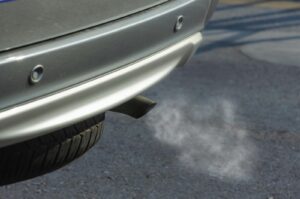Hybrids…Solution or Stop Gap?
The transition to carbon-neutral transport isn’t easy — but it is achievable if internal combustion engines are removed from the road, writes Sasha Sequeira and Jason Stonier from Siemens Mobility Limited.
The growth in ownership of hybrid and electric vehicles (EVs) is having a major impact on both the UK Government’s decarbonisation targets for the transport sector and the air quality targets set for individual cities.
The Government’s recent decision to bring the date after which sales of petrol and diesel cars will be banned forward to 2030, will see this growth rise sharply over the coming decade.
The transport sector is currently the largest emitting sector in the UK economy, accounting for more than 21% of UK greenhouse gases,[1] with road transport accounting for 91%[2] of domestic transport emissions. And while all other industries have reduced their carbon dioxide emissions significantly since 1990, the transport sector has remained almost static over the same period.
The potential impact that a growing EV fleet could have on air quality has been made abundantly clear during the coronavirus pandemic, and particularly the period of strict lockdown. With a reduction in the number of cars on UK roads, and indeed worldwide, we have seen significant improvements in local air quality and with it, wide-ranging environmental and health benefits.
The benefits of EVs lie in their significantly lower ‘well-to-wheel’ emissions. A petrol-engine car has a typical efficiency of 25 to 30% – meaning that at least 70% of the energy in the fuel is wasted as heat and in exhaust gases. By contrast, a combined-cycle gas turbine (CCGT) power plant has a typical efficiency of over 60%.
Even accounting for transmission losses, this makes an electric vehicle powered from a CCGT power plant almost double the well-to-wheel efficiency of a typical fossil-fuelled car, and as the proportion of our energy generated by wind and other sustainable sources increases, the carbon debt of transport will fall dramatically.
As ideal as it would be for the entire country to switch to EVs immediately, it is not yet feasible. Underlying problems in the grid infrastructure, lags in battery technology, the need for more Government incentives, and high market prices all mean that a full nationwide electric fleet cannot be supported just yet.
The availability of public chargers is a concern for many, and with some old and unreliable technology, that concern may well be justified. A focus on the quality of hardware, and more importantly on maintenance and service, will instil confidence. One way in which Siemens stands out in this area is our nationwide service engineering coverage and class-leading after sales support.
Hybrid vehicles (which run partly on electric power with the option of also running on fuel) are seen by many as an excellent halfway house, helping to transition car owners to fully electric vehicles by building their confidence in the technology.
Hybrids also add a measure of business security, lowering the risks of innovation and technology introduction.
By providing the option of switching to fuel, they also partly solve the problem of ‘range anxiety’ — fears over the distance EVs can travel — which is arguably the greatest barrier to the uptake of battery-electric vehicles. Hybrids encourage people to go at least the ‘first mile’ with a battery vehicle and experience the benefits of driving an EV in a low-risk way.
However, there is some debate as to how environmentally sound hybrid vehicles are.
In many ways, they are a sub-optimal solution, with their low battery range often tempting people to run them as a ‘normal’ fuel vehicle with their large engines made less efficient by hauling a boot-full of batteries around.
Although hybrids are a step in the right direction, they shouldn’t be an excuse to sit back and reduce the focus on the ultimate goal of adopting battery-electric vehicles.
Market factors such as an improved and increasingly reliable charging infrastructure, more charging locations, new battery technology, and the hydrogen economy should all combine to make hybrids obsolete for most consumers within the next few years. But, in the meantime, they might just be the stopgap we need to support the transition to battery electric vehicles.
The transition to carbon-neutral transport isn’t easy — but it is achievable if internal combustion engines are removed from the road. The UK is a world leader in renewable energy, with over 40% [3] of our power coming from sustainable sources.
As part of that, we have some of the highest wind-power potential in the world, with approximately 22%3 of our power already coming from wind turbines (a 10-fold increase since 2010).
If we are able to decouple energy production from energy use, with new storage and transportation vectors, then we have the potential to almost completely decarbonise our power supply within a generation.
Siemens has a stake in this new world, with some major innovations across its many business portfolios in energy management and distribution.
A particularly exciting project uses wind power in off-grid locations to produce hydrogen by electrolysis, which is later used to produce electricity through fuel cells to run estates of EV chargers in areas of constrained power grid. Another innovative project will see Siemens Energy and Siemens Mobility jointly develop and offer hydrogen systems for trains.
These, and other innovations in this exciting industry, mean that Net Zero is achievable.
The UK Government’s ten-point plan for a green industrial revolution certainly backs this up. Earlier this year the Government revised its 2040 target for the ban on sales of diesel and petrol vehicles — bringing it back to 2035.
In November, this target was again revised back to 2030, which not only shows the Government’s commitment to its Net Zero aspirations — but also clearly aligns with the trend in the consumer vehicle market, with year-on-year sales of battery vehicles far exceeding expectations.
Furthermore, the sale of certain hybrids will be allowed through to 2035 to support the transition, although consumer demand and improvements in technology are likely to phase out hybrids well before then — with some manufacturers already stating their intent to phase out all internal combustion before 2030.
The Government’s announcement was timely. In 2021 the UK hosts COP 26 and with aggressive environmental targets and talk of a green industrial revolution in this country, the UK’s place as a leader in this critical and dynamic space could be cemented as we accelerate the path to Net Zero.
References:
[1] DfT. (2020). Decarbonising Transport Setting the Challenge. Department for Transport. London: Crown Copyright. [Online]. Available at: https://assets.publishing.service.gov.uk/government/uploads/system/uploads/attachment_data/file/876251/decarbonising-transport-setting-the-challenge.pdf
2 HM Treasury. (2020). Policy Paper Budget 2020. London: Crown Copyright. [Online]. Available at: https://www.gov.uk/government/publications/budget-2020-documents/budget-2020
[3]https://assets.publishing.service.gov.uk/government/uploads/system/uploads/attachment_data/file/920621/Renewables_September_2020.pdf














